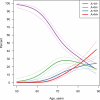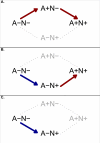Age-specific population frequencies of cerebral β-amyloidosis and neurodegeneration among people with normal cognitive function aged 50-89 years: a cross-sectional study
- PMID: 25201514
- PMCID: PMC4324499
- DOI: 10.1016/S1474-4422(14)70194-2
Age-specific population frequencies of cerebral β-amyloidosis and neurodegeneration among people with normal cognitive function aged 50-89 years: a cross-sectional study
Abstract
Background: As preclinical Alzheimer's disease becomes a target for therapeutic intervention, the overlap between imaging abnormalities associated with typical ageing and those associated with Alzheimer's disease needs to be recognised. We aimed to characterise how typical ageing and preclinical Alzheimer's disease overlap in terms of β-amyloidosis and neurodegeneration.
Methods: We measured age-specific frequencies of amyloidosis and neurodegeneration in individuals with normal cognitive function aged 50-89 years. Potential participants were randomly selected from the Olmsted County (MN, USA) population-based study of cognitive ageing and invited to participate in cognitive and imaging assessments. To be eligible for inclusion, individuals must have been judged clinically to have no cognitive impairment and have undergone amyloid PET, (18)F-fluorodeoxyglucose ((18)F-FDG) PET, and MRI. Imaging results were obtained from March 28, 2006, to Dec 3, 2013. Amyloid status (positive [A(+)] or negative [A(-)]) was determined by amyloid PET with (11)C Pittsburgh compound B. Neurodegeneration status (positive [N(+)] or negative [N(-)]) was determined by an Alzheimer's disease signature (18)F-FDG PET or hippocampal volume on MRI. We determined age-specific frequencies of the four groups (amyloid negative and neurodegeneration negative [A(-)N(-)], amyloid positive and neurodegeneration negative [A(+)N(-)], amyloid negative and neurodegeneration positive [A(-)N(+)], or amyloid positive and neurodegeneration positive [A(+)N(+)]) cross-sectionally using multinomial regression models. We also investigated associations of group frequencies with APOE ɛ4 status (assessed with DNA extracted from blood) and sex by including these covariates in the multinomial models.
Findings: The study population consisted of 985 eligible participants. The population frequency of A(-)N(-) was 100% (n=985) at age 50 years and fell to 17% (95% CI 11-24) by age 89 years. The frequency of A(+)N(-) increased to 28% (24-32) at age 74 years, then decreased to 17% (11-25) by age 89 years. The frequency of A(-)N(+) increased from age 60 years, reaching 24% (16-34) by age 89 years. The frequency of A(+)N(+) increased from age 65 years, reaching 42% (31-52) by age 89 years. The results from our multinomial models suggest that A(+)N(-) and A(+)N(+) were more frequent in APOE ɛ4 carriers than in non-carriers and that A(+)N(+) was more, and A(+)N(-) less frequent in men than in women.
Interpretation: Accumulation of amyloid and neurodegeneration are nearly inevitable by old age, but many people are able to maintain normal cognitive function despite these imaging abnormalities. Changes in the frequency of amyloidosis and neurodegeneration with age, which seem to be modified by APOE ɛ4 and sex, suggest that pathophysiological sequences might differ between individuals.
Funding: US National Institute on Aging and Alexander Family Professorship of Alzheimer's Disease Research.
Copyright © 2014 Elsevier Ltd. All rights reserved.
Figures




Comment in
-
At the crossroads of preclinical AD and normal brain ageing.Lancet Neurol. 2014 Oct;13(10):965-6. doi: 10.1016/S1474-4422(14)70207-8. Epub 2014 Sep 4. Lancet Neurol. 2014. PMID: 25201513 Free PMC article. No abstract available.
-
Bringing forward the diagnosis of Alzheimer's disease.Lancet Neurol. 2014 Oct;13(10):961. doi: 10.1016/S1474-4422(14)70211-X. Lancet Neurol. 2014. PMID: 25231514 No abstract available.
References
-
- Villemagne VL, Burnham S, Bourgeat P, et al. Amyloid beta deposition, neurodegeneration, and cognitive decline in sporadic Alzheimer's disease: a prospective cohort study. Lancet Neurol. 2013;12:357–67. - PubMed
-
- Dubois B, Feldman HH, Jacova C, et al. Advancing research diagnostic criteria for Alzheimer's disease: the IWG-2 criteria. Lancet Neurol. 2014;13:614–29. - PubMed
Publication types
MeSH terms
Substances
Grants and funding
- P50 AG16574/AG/NIA NIH HHS/United States
- R01 AG041851/AG/NIA NIH HHS/United States
- R01 AG029550/AG/NIA NIH HHS/United States
- U01-AG024904/AG/NIA NIH HHS/United States
- R01AG043392/AG/NIA NIH HHS/United States
- R01-AG11378/AG/NIA NIH HHS/United States
- R01 AG011378/AG/NIA NIH HHS/United States
- R01 AG37551/AG/NIA NIH HHS/United States
- AG 29550/AG/NIA NIH HHS/United States
- U01-AG06786/AG/NIA NIH HHS/United States
- U01 AG006786/AG/NIA NIH HHS/United States
- R01 AG034676/AG/NIA NIH HHS/United States
- R01AG040042/AG/NIA NIH HHS/United States
- P50 AG016574/AG/NIA NIH HHS/United States
- U01 HL096917/HL/NHLBI NIH HHS/United States
- R01AG32990/AG/NIA NIH HHS/United States
- U01 AG024904/AG/NIA NIH HHS/United States
- U01-24904/PHS HHS/United States
- P50AG16574/AG/NIA NIH HHS/United States
- U01AG06786/AG/NIA NIH HHS/United States
- R01 AG037551/AG/NIA NIH HHS/United States
- P50-AG16574/AG/NIA NIH HHS/United States
- U01-HL096917/HL/NHLBI NIH HHS/United States
- R01 AG032306/AG/NIA NIH HHS/United States
- R01 AG043392/AG/NIA NIH HHS/United States
- UL1 TR000135/TR/NCATS NIH HHS/United States
- R01 AG032990/AG/NIA NIH HHS/United States
- AG32306/AG/NIA NIH HHS/United States
- U01 AG06786/AG/NIA NIH HHS/United States
- P50 AG044170/AG/NIA NIH HHS/United States
- R01-AG011378/AG/NIA NIH HHS/United States
- U01 96917/PHS HHS/United States
LinkOut - more resources
Full Text Sources
Other Literature Sources
Medical
Research Materials
Miscellaneous

